UPSC Daily Current Affairs: 17th October 2024 | Current Affairs & Hindu Analysis: Daily, Weekly & Monthly PDF Download
GS3/Economy
Union Government Announces MSP Hike for Rabi Crops
Source: The Hindu
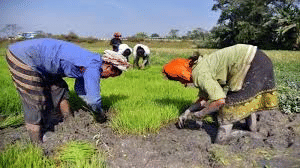
Why in News?
The Union government has declared minimum support prices (MSP) for six rabi crops for the 2025-26 marketing season, notably increasing the MSP for wheat by ₹150 per quintal to ₹2,425, marking a 6.59% rise from the previous MSP.
About MSP:
- MSP serves as a market intervention tool by the Government of India to protect agricultural producers against significant drops in prices during years of high production.
- It is determined by the Cabinet Committee on Economic Affairs, chaired by the Prime Minister, based on recommendations from the Commission for Agricultural Costs and Prices (CACP) at the start of the sowing season.
- The primary goal of MSPs is to guarantee a minimum price for farmers' produce, preventing distress sales and ensuring the procurement of food grains for distribution.
- For instance, if market prices fall below the MSP due to surplus supply, government agencies are obligated to purchase the entire quantity offered by farmers at the announced minimum price.
- The MSP hikes are crucial for both the welfare of farmers and for stabilizing agricultural markets, particularly as India seeks to boost domestic pulse production amidst increasing imports.
Background:
- The agricultural sector in India suffered greatly under British colonial rule, leading to widespread impoverishment among farmers.
- The Food-Grain Enquiry Committee, formed by Jawaharlal Nehru's government in 1957, was the first major attempt to address farmers' earnings.
- In 1964, Lal Bahadur Shastri established the Food Grain Price Committee to advocate for an MSP regime.
- The first MSP was announced in 1967 by Agriculture Minister Jagjivan Ram, marking the formal introduction of this pricing system, which was intended to be uniformly applied across India.
- The Agricultural Prices Commission, later renamed the CACP in 1985, was tasked with setting MSPs for various crops.
Crops Covered:
- The government announces MSPs for 22 mandated crops and a fair and remunerative price (FRP) for sugarcane, totaling 23 crops.
- The mandated crops include 14 kharif crops and 6 rabi crops: Wheat, Barley, Gram, Masur (Lentil), Rapeseed & Mustard, and Safflower.
Issues Faced by the MSP Regime in India:
- Limited Coverage: MSP only applies to selected crops within the government procurement system, leaving many farmers vulnerable as they cultivate crops not covered by MSP.
- Regional Disparities: The effectiveness of MSP varies by state, with some areas having better procurement systems than others, leading to unequal support for farmers.
- Discouraging Diversification: The reliance on MSP can lead farmers to focus heavily on certain crops, hindering crop diversification and causing market imbalances.
- Procurement Challenges: Although MSP aims to provide fair pricing, procurement processes can be inefficient, with issues such as payment delays and inadequate storage affecting farmers' benefits.
- Market Distortions: MSP can disrupt market signals, prompting farmers to produce crops primarily for government support rather than in response to market demand, which may lead to excess production and waste.
- Neglect of Non-Cereal Crops: The MSP system has historically prioritized staple crops like wheat and rice, often overlooking pulses and oilseeds, impacting nutritional diversity.
- Inflationary Pressure: Raising MSP without improving productivity can contribute to food price inflation, which affects consumers and the broader economy.
- Sustainability Concerns: Focusing on certain crops can lead to unsustainable farming practices, including excessive water usage and soil degradation, jeopardizing long-term agricultural health.
- Underutilization of Support: Many farmers lack awareness of MSP policies and how to access them, leading to underutilization of available assistance.
- Political Interference: MSP decisions may be swayed by political factors, resulting in inconsistencies in pricing and procurement policies that do not reflect economic realities.
News Summary Regarding MSP Hike for Rabi Crops:
- Details of MSP Adjustments: The government has justified the MSP hikes, stating they are aimed at ensuring fair prices for farmers and promoting crop diversification.
- Government’s Justification:Despite upcoming elections in states like Maharashtra and Jharkhand, the government claimed there were no political motives behind the announcement's timing.
- The increase in MSP for the mandated Rabi Crops for the Marketing Season 2025-26 is consistent with the Union Budget 2018-19 commitment to set MSPs at least 1.5 times the All-India weighted average cost of production.
- The expected margin over the All-India weighted average cost of production varies by crop, with wheat leading at 105%, followed by rapeseed & mustard at 98%, lentil at 89%, gram and barley both at 60%, and safflower at 50%.
- Significance of Wheat Crop: Wheat is the second-largest crop in India, with an estimated production of 113.92 million tonnes for 2023-24. Major producing states include UP, MP, and Punjab. During the current marketing season, the government has procured 26.6 million tonnes of wheat, benefiting approximately 22 lakh farmers.
GS1/History & Culture
Battle of Walong
Source: The Hindu

Why in News?
To commemorate the 62nd anniversary of the significant Battle of Walong during the 1962 war with China, the Army has organized a series of commemorative events spanning a month.
About Battle of Walong:
- The battle took place during the 1962 Sino-Indian War.
- It was fought at the easternmost point of Arunachal Pradesh, close to the tri-junction of India, China, and Myanmar.
- As Chinese forces initiated a comprehensive offensive, Indian troops were assigned the critical task of defending Walong, which was the sole advanced landing ground in that area.
- This location served as a crucial supply route connecting remote border outposts.
- Following Tawang, Walong represented China's principal offensive in the eastern sector during the conflict.
- The Chinese military had a significant numerical advantage, with approximately 15,000 soldiers compared to India's 2,500, along with superior weaponry and artillery support.
- Despite being heavily outnumbered and outgunned, the Indian soldiers exhibited extraordinary determination and bravery.
- Units of the Indian Army involved in this battle included the Kumaon Regiment, Sikh Regiment, Gorkha Rifles, Assam Rifles, and Dogra Regiment.
- Through their tenacity and courage, they successfully impeded the Chinese advance for almost three weeks, despite facing severe shortages of ammunition and supplies.
- The battle resulted in substantial casualties for India, with around 830 soldiers either killed, wounded, or captured.
- Nevertheless, their defense remains a potent symbol of the valor and sacrifice of the Indian Army.
- This battle is historically noted as the only counterattack by India during the 1962 war.
GS3/Economy
What is Kaizen?
Source: Cloudwards

Why in News?
The month-long strike at Samsung’s manufacturing facility in Tamil Nadu has highlighted the challenging working conditions in these factories, which are shaped by a management philosophy inspired by the Japanese production method known as Kaizen.
About Kaizen:
- Kaizen is derived from two Japanese words that together mean "good change" or "improvement."
- This Japanese business philosophy promotes continuous improvement by involving employees at every level of the organization.
- Kaizen encompasses various ideas, including:
- Enhancing the work environment through a collaborative team atmosphere.
- Streamlining processes and procedures for improved efficiency.
- Ensuring employee engagement to foster a sense of ownership.
- Making jobs more rewarding, less exhausting, and safer.
- The primary goal of Kaizen is to implement small, incremental changes over time to drive ongoing improvement within a company.
- This approach acknowledges that small adjustments can accumulate and lead to significant impacts in the long run.
- Benefits of the Kaizen philosophy include:
- Enhanced quality control.
- More efficient operational processes.
- Reduction of waste.
- Under the Kaizen framework, any employee can initiate improvements at any time.
- The underlying philosophy is that everyone plays a role in the company’s success and should continually strive to enhance the business.
GS3/Environment
The Impact of Climate Change on Poor Farmers in India: FAO Report
Source: The Hindu
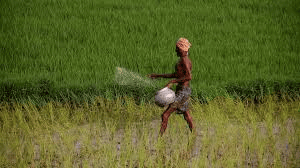
Why in news?
A new report from the Food and Agriculture Organization (FAO) sheds light on the disproportionate effects of climate change on poorer farming communities in India. Titled “The Unjust Climate: Measuring the Impacts of Climate Change on Rural Poor, Women, and Youth,” this report highlights the various vulnerabilities that marginalized farmers face due to climate-induced phenomena such as heat stress, floods, and droughts.
Background:
- A recent FAO report discusses how climate change negatively impacts poorer farmers in India.
- The report, titled “The Unjust Climate: Measuring the Impacts of Climate Change on Rural Poor, Women, and Youth,” reveals the hardships faced by these communities.
- Climate-induced stresses, including heat stress, floods, and droughts, exacerbate their vulnerabilities.
About Food and Agriculture Organization (FAO):
- The FAO is a specialized agency of the United Nations focused on combating hunger, improving nutrition, and ensuring food security.
- Since its establishment in 1945, FAO has been headquartered in Rome, Italy.
- Its mission includes raising nutritional standards, enhancing agricultural productivity, and improving the livelihoods of rural populations through sustainable agricultural practices.
Key Objectives of FAO:
- Eradicating Hunger and Food Insecurity: Striving for a world free from hunger and ensuring access to safe, nutritious food for all.
- Sustainable Agriculture: Promoting sustainable agricultural methods to boost productivity while conserving natural resources like soil, water, and biodiversity.
- Improving Rural Livelihoods: Supporting smallholder farmers and rural communities with tools, knowledge, and market access to enhance economic opportunities.
- Tackling Climate Change: Engaging in efforts to mitigate the effects of climate change on food systems and advocating for resilient farming practices.
Key Highlights of the Report:
- The FAO presented its findings on climate change impacts at an event in New Delhi.
Key Findings of the Report:
- Income Disparities: Poor households globally lose about 5% of their income each year due to heat stress and 4.4% due to floods, while wealthier households are less affected.
- In India, rural poor households are especially vulnerable as their incomes heavily depend on climate-sensitive agricultural practices.
Structural Inequalities:
- The report indicates that the vulnerability of poor farmers is rooted in systemic inequalities.
- Households exposed to climate stress experience a more significant income reduction compared to those unaffected.
- Poor farmers often invest more resources into maintaining agricultural production during adverse conditions, limiting their off-farm employment opportunities.
Impact of Heat Stress and Floods:
- Climate change is widening the income gap between poor and non-poor households globally.
- Floods alone contribute to an annual income gap increase of approximately $21 billion, while heat stress adds over $20 billion.
- In India, rising temperatures have led to increased reliance on farming for poor households, with off-farm incomes declining by 33%.
Policy Recommendations:
- The FAO recommends expanding social security nets for vulnerable communities.
- It suggests anticipatory social protection programs to provide livelihood support before extreme weather events, which can help reduce poverty and dependency on harmful coping strategies.
- Addressing gender barriers in employment and promoting workforce diversification is crucial.
- Mentorship programs should be established to help rural communities adapt to modern job markets.
- Empowering women in rural areas is essential to combat climate change effects.
- Implementing gender-transformative approaches can challenge discriminatory norms, enabling women to make impactful economic decisions.
- Initiatives to enhance socio-emotional skills are necessary for women and youth to thrive in the evolving job landscape.
NITI Aayog’s Response:
- In response to the FAO report, a member of NITI Aayog highlighted India's proactive stance against climate change challenges.
- Key initiatives include the National Innovations on Climate Resilient Agriculture (NICRA), which assists farmers in adapting to extreme weather.
- India also leads with employment guarantee schemes, such as the Mahatma Gandhi National Rural Employment Guarantee Scheme, ensuring economic security.
- During the COVID-19 pandemic, the government distributed free food grains through the Pradhan Mantri Garib Kalyan Anna Yojana to two-thirds of the population, demonstrating a commitment to addressing climate and economic challenges.
- Recent data shows a notable increase in women’s workforce participation, indicating progress towards gender equality in employment opportunities.
GS3/Environment
International Solar Alliance Assembly
Source: AIR
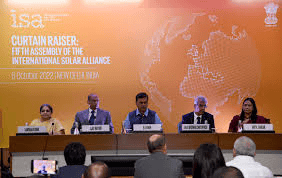
Why in news?
Recently, New Delhi hosted the curtain raiser for the Seventh Session of the International Solar Alliance (ISA) Assembly.
About International Solar Alliance Assembly:
- The ISA Assembly serves as the highest decision-making authority for the ISA, representing all member countries.
- It is responsible for making decisions related to the implementation of the ISA’s Framework Agreement and coordinating actions to fulfill its objectives.
- The Assembly meets annually at the ministerial level at the ISA's headquarters.
- It evaluates the overall impact of programs and activities concerning solar energy deployment, performance, reliability, cost, and financing.
Members:
- Currently, 120 countries are signatories to the ISA Framework Agreement, with 102 having ratified it to become full members.
- India holds the presidency of the ISA Assembly, while France serves as the co-president.
Focus of the Seventh Session:
- The session will discuss initiatives that enhance energy access, security, and transitions, emphasizing:
- Empowering member countries to make solar energy their preferred energy source.
- Ensuring universal energy access by assisting solar entrepreneurs in scaling local solutions.
- Mobilizing financial resources to accelerate the deployment of solar energy solutions.
What is the International Solar Alliance?
- The ISA was established during the 21st Conference of Parties (COP21) to the United Nations Framework Convention on Climate Change (UNFCCC) in Paris in 2015.
- It is a collaborative platform driven by its members to enhance the deployment of solar energy technologies.
- The headquarters of the ISA is located at the National Institute of Solar Energy (NISE) in Gurugram, India.
GS3/Science and Technology
Drugs Technical Advisory Board
Source: The Hindu

Why in news?
Recently, the Drugs Technical Advisory Board (DTAB) has proposed that all antibiotics be classified under the definition of new drugs as per the New Drugs and Clinical Trial (NDCT) Rules, 2019.
About Drugs Technical Advisory Board:
- DTAB serves as the principal statutory body responsible for making key decisions on technical drug-related issues in India.
- It was established under the Drugs and Cosmetics Act of 1940.
- DTAB operates under the Central Drugs Standard Control Organization (CDSCO).
Function:
- Provides advice to both the Central Government and State Governments on technical issues arising from the implementation of the Drugs and Cosmetics Act of 1940.
- Conducts various other functions assigned to it by the Act.
Nodal Ministry:
- The Ministry of Health and Family Welfare is the nodal ministry overseeing DTAB's operations.
What is a new drug?
- As defined by Rule 122 E of the Drug and Cosmetic Rules of 1945, a new drug is one that has not been previously utilized in the country and has not been acknowledged as effective or safe by the licensing authority for the intended claims.
- This category can also include existing drugs that have altered or new claims regarding their use, such as indications, dosage, or method of administration.
If antibiotics are included in the new drug classification:
- Documentation will be required for the manufacturing, marketing, and sale of antibiotics.
- Manufacturing and marketing approvals will need to be secured from the Central Government instead of the State drug administration.
- Patients will be required to obtain prescriptions to purchase antibiotics.
GS3/Environment
Bushveld Igneous Complex
Source: Sci Tech Daily
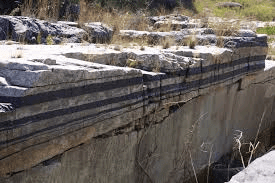
Why in news?
Researchers have recently uncovered living microbes in a rock that is approximately 2 billion years old from the Bushveld Igneous Complex in South Africa. This discovery offers valuable insights into the early forms of life on Earth and could also assist in the exploration for life on Mars.
Overview of the Bushveld Igneous Complex (BIC)
- BIC is recognized as the largest layered igneous intrusion found within the Earth's crust.
- Located in northern South Africa, it is exposed at the edge of the Transvaal Basin.
- The complex spans a pear-shaped area exceeding 66,000 square kilometers.
- Its thickness varies, occasionally reaching up to 9 kilometers (5.6 miles).
- Renowned for its rich ore deposits, BIC contains the world's largest reserves of platinum-group metals (PGMs).
- These PGMs include metals such as platinum, palladium, osmium, iridium, rhodium, and ruthenium.
- Additionally, BIC holds vast amounts of iron, tin, chromium, titanium, and vanadium.
- The complex is divided into eastern and western lobes, with a northern extension, formed around the same time, approximately 2 billion years ago.
Formation of the Bushveld Igneous Complex
- The BIC was formed by vast quantities of molten rock that originated from the Earth's mantle.
- This molten rock was brought to the surface through long vertical cracks in the Earth's crust.
- The geological intrusion known as BIC resulted from these injections of molten rock over time.
- As the molten rock cooled, different minerals crystallized at varying temperatures, leading to a structure resembling a layered cake.
- This layered structure consists of distinct rock strata, including three layers known as reefs that are rich in PGMs.
GS3/Environment
What is the Graded Response Action Plan (GRAP)?
Source: Hindustan Times
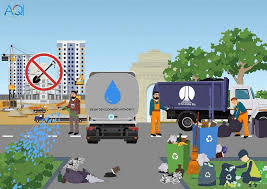
Why in News?
The Centre's air pollution control panel for Delhi-NCR recently directed state governments in the region to implement the first stage of the Graded Response Action Plan (GRAP).
Overview of GRAP:
- GRAP is a structured framework aimed at addressing air pollution issues specifically in the Delhi-NCR region.
- It serves as an emergency response protocol activated when the Air Quality Index (AQI) reaches "poor" levels.
- The plan is particularly critical during winter months when air quality often deteriorates significantly.
Implementation of GRAP:
- The Commission for Air Quality Management (CAQM) is responsible for overseeing the GRAP's implementation in NCR and surrounding areas.
- CAQM works in conjunction with the Ministry of Environment, Forest and Climate Change (MoEFCC) to ensure effective execution.
- A sub-committee has been formed by CAQM to operationalize GRAP, comprising officials from various pollution control boards and scientific experts.
- This sub-committee is tasked with meeting regularly to issue directives necessary for invoking GRAP measures.
- In instances of conflicting orders, the directives from CAQM take precedence over those from state governments.
Stages of GRAP:
- Stage I: Activated when air quality is classified as "Poor" (Delhi AQI: 201-300).
- Stage II: Activated when air quality is classified as "Very Poor" (Delhi AQI: 301-400).
- Stage III: Activated for "Severe" conditions (Delhi AQI: 401-450).
- Stage IV: Activated for "Severe+" conditions (Delhi AQI > 450).
Understanding the Air Quality Index (AQI):
- AQI is a tool used by government agencies to measure air pollution levels and convey associated health risks to the public.
- This index reflects the potential impact of air pollution on health, with higher AQI values indicating greater health hazards.
- AQI is computed based on the concentrations of various air pollutants over a defined timeframe.
- Results are segmented into categories with specific health advisories, as follows:
- 0 to 50: "Good"
- 51 to 100: "Satisfactory"
- 101 to 200: "Moderate"
- 201 to 300: "Poor"
- 301 to 400: "Very Poor"
- 401 to 450: "Severe"
- Above 450: "Severe+"
GS3/Economy
SAMARTH Scheme
Source: New Indian Express
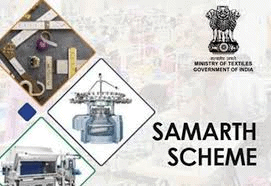
Why in News?
Recently, the central government has decided to continue the Samarth Scheme for an additional two years (FY 2024-25 and 2025-26) with an allocated budget of Rs. 495 Crore aimed at training 3 lakh individuals in textile-related skills.
About SAMARTH Scheme:
- The Scheme for Capacity Building in Textiles Sector (SAMARTH) is a placement-oriented skilling program that responds to industry demand.
- Aim: The primary goal is to encourage and enhance the industry's efforts in generating employment opportunities within the organized textile and related sectors, focusing on the entire textile value chain while excluding spinning and weaving processes.
- In addition to providing entry-level skills, a special initiative for upskilling and re-skilling has been introduced to boost the productivity of current workers specifically in the Apparel & Garmenting segments.
Implementation Agencies:
- Textile Industry partners.
- Institutions and organizations affiliated with the Ministry of Textiles or State Governments that possess training facilities and established placement connections with the textile sector.
- Reputable training institutions, NGOs, societies, trusts, organizations, companies, startups, and entrepreneurs engaged in the textile industry that have placement partnerships with textile firms.
Nodal Ministry:
- Ministry of Textiles.
GS1/Geography
NORTH KOREA BLOWS UP KEY ROAD LINKS TO SOUTH KOREA
Source: Indian Express
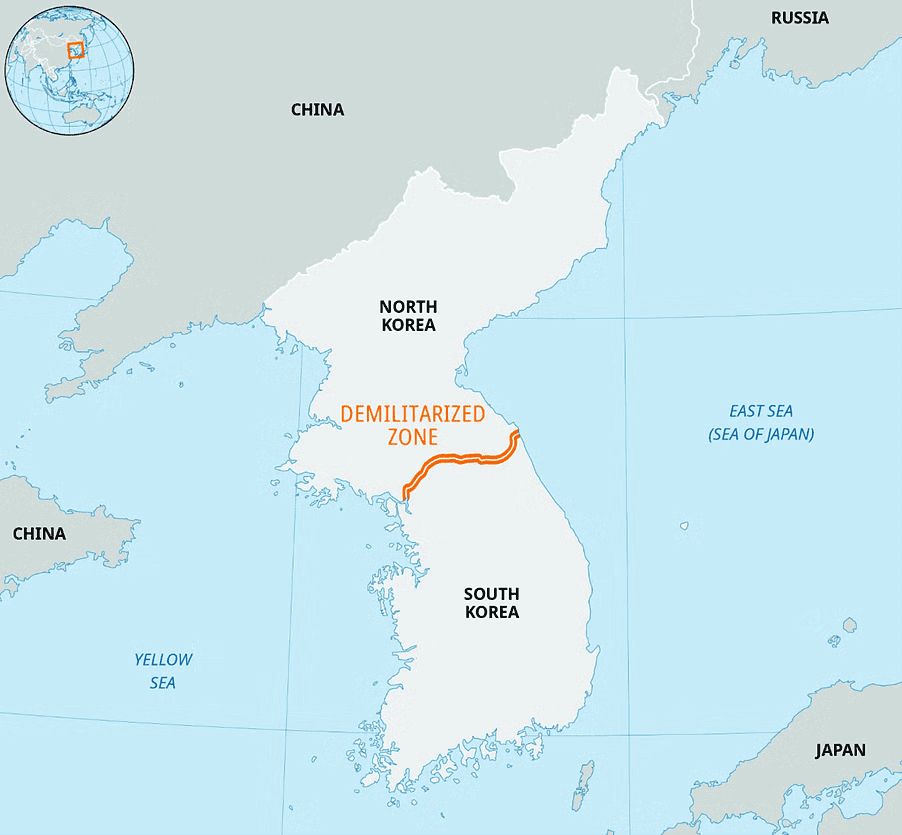
Why in News?
North Korea detonated explosives on key road and railway links connecting its territory to South Korea.
- This destruction, while the roads had not been operational for years, carries significant symbolic weight, highlighting the ongoing division between the Koreas, separated by one of the most fortified borders globally.
- During the inter-Korean détente in the 2000s, two roads and two railway lines were reopened across the heavily fortified border, but their use diminished as tensions escalated over North Korea's nuclear ambitions and other conflicts.
- The recent explosions were a response to North Korea's accusations that South Korea had deployed propaganda-laden drones over Pyongyang, the capital of North Korea.
- Earlier in the month, North Korean leader Kim Jong Un abandoned the previous policy of pursuing peaceful reunification with South Korea, now characterizing the relationship as one between "two hostile nations."
About North Korea – South Korea Border
- The border separating North Korea and South Korea is known as the Demilitarized Zone (DMZ).
- This zone runs approximately along the 38th parallel, effectively dividing the Korean Peninsula into the two nations.
- The DMZ has a length of about 250 kilometers and a width of approximately 4 kilometers, making it one of the most heavily militarized borders worldwide.
- The establishment of the DMZ occurred after the Korean Armistice Agreement in 1953, which concluded the Korean War with a ceasefire, not a peace treaty, leaving the two Koreas in a state of technical war.
Military Demarcation Line (MDL)
- Within the DMZ is the Military Demarcation Line (MDL), which represents the actual border between North and South Korea.
- This border serves as a powerful symbol of the Cold War divide, contrasting the communist regime of North Korea (DPRK) with the democratic governance of South Korea (ROK), which is allied with the United States.
GS3/Science and Technology
Satcom Spectrum To Be Allocated Administratively
Source: Economic Times

Why in news?
Speaking on the sidelines of the India Mobile Congress, the Telecom Minister announced that satellite communication (satcom) spectrum will be allocated through an administrative process rather than through auctions, but this will incur a cost. The Telecom Regulatory Authority of India (TRAI) will determine the pricing and allocation methodology.
Airwaves/Spectrum
- Airwaves are radio frequencies that allow wireless transmission of information for various services, including telecommunications.
- The government is responsible for managing and distributing these frequencies to companies and sectors.
- Typically, the government conducts auctions for a limited amount of spectrum in designated bands for operators to provide communication services.
About Satellite Spectrum
- Satellite spectrum encompasses radio frequencies used by satellites for communication with ground stations, other satellites, and devices on Earth.
- These frequencies are part of the electromagnetic spectrum and are designated for services such as communication, broadcasting, navigation, and Earth observation.
- Regulation
- The use of satellite spectrum is overseen by international organizations like the International Telecommunication Union (ITU), which allocates frequencies to minimize interference between satellite systems and other communication forms.
Satellite Frequency Bands
- L-band (1-2 GHz): Utilized for GPS and mobile satellite services.
- S-band (2-4 GHz): Employed for weather radar, air traffic control, and mobile satellite services.
- C-band (4-8 GHz): Commonly used for satellite television broadcasting and data communications.
- X-band (8-12 GHz): Primarily used by the military for radar and communication.
- Ku-band (12-18 GHz) and Ka-band (26-40 GHz): Used for satellite television, internet, and high-speed data transmission.
Auctions vs Administrative Allocation
- Auctions involve competitive bidding where spectrum licenses are awarded to the highest bidder, ensuring efficient resource distribution and generating government revenue.
- This transparent method reduces favoritism and is commonly used in commercial telecommunications to maximize spectrum usage.
- Auctions are advantageous in competitive markets with multiple bidders.
Administrative Allocation
- This method involves the government directly assigning spectrum licenses without a competitive bidding process, often for a nominal fee covering administrative costs.
- Administrative allocation is suitable for sectors such as national security and public services, or emerging industries like satellite communications, where auctions may not be practical.
- It provides easier access to resources for specialized services or government-related applications.
Key Differences
- Auctions are competitive and revenue-generating, ensuring transparency by allocating spectrum to the highest bidder, making them suited for commercial markets.
- Administrative allocations are directly assigned by the government with lower fees, offering more flexibility but less transparency, suitable for government services or specialized sectors.
About the News
- The Indian government has opted for administrative allocation of satellite communication spectrum, bypassing the auction method.
- This decision reflects the increasing competition within the Indian satellite services market, projected to grow at an annual rate of 36% and reach $1.9 billion by 2030.
- Starlink, founded by Elon Musk, supports direct licensing and advocates for spectrum to be treated as a shared resource, while Reliance argues for auctions to ensure fair competition.
Rationale Behind India's Stand
- Unlike terrestrial spectrum used for mobile communications, satellite spectrum is international and does not have national territorial limits.
- As satellite spectrum is shared, it cannot be individually priced, leading to administrative allocation practices worldwide.
- India, as a member of the ITU, opted for administrative allocation to align with global practices.
- The Telecommunications Act of 2023 included satellite communication spectrum in the administrative allocation framework.
Controversies Surrounding Spectrum Allocation
- India's spectrum allocation has faced scrutiny, particularly regarding the transition from auctions to administrative assignments, highlighted by the 2G spectrum scam.
- This scandal involved licenses being distributed on a first-come, first-served basis, resulting in substantial financial losses, including claims of Rs 30,984 crore and a presumptive loss of Rs 1.76 trillion.
- The Supreme Court mandated auctions for spectrum allocation in 2012 in response to these issues.
- Nonetheless, the Telecommunications Act 2023 has introduced a non-auction method for allocating satellite spectrum, signaling a shift in regulatory strategy.
|
38 videos|5288 docs|1117 tests
|
















